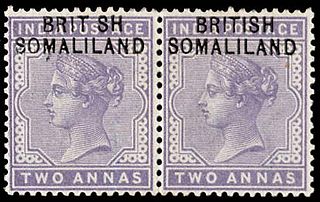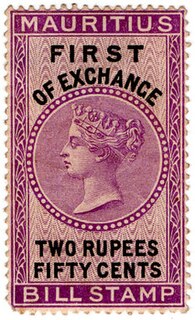Related Research Articles

Originally mail from British Somaliland used postage stamps of Egypt, then India. In 1903, about 30 types of stamps of India were overprinted "BRITISH / SOMALILAND".

A revenue stamp, tax stamp, duty stamp or fiscal stamp is a (usually) adhesive label used to collect taxes or fees on documents, tobacco, alcoholic drinks, drugs and medicines, playing cards, hunting licenses, firearm registration, and many other things. Typically businesses purchase the stamps from the government, and attach them to taxed items as part of putting the items on sale, or in the case of documents, as part of filling out the form.

India has been a heavy user of revenue stamps, both before and after independence. The first revenues were issued in the mid-nineteenth century and they are still being issued to this day. Apart from issues for the whole of India, many princely states, provinces and other states also had or still have their own revenue stamp issues.

Revenue stamps of Malta were first issued in 1899, when the islands were a British colony. From that year to 1912, all revenue issues were postage stamps overprinted accordingly, that was either done locally or by De La Rue in London. Postage stamps also became valid for fiscal use in 1913, so no new revenues were issued until 1926–30, when a series of key type stamps depicting King George V were issued. These exist unappropriated for use as general-duty revenues, or with additional inscriptions indicating a specific use; Applications, Contracts, Registers or Stocks & Shares. The only other revenues after this series were £1 stamps depicting George VI and Elizabeth II. Postage stamps remained valid for fiscal use until at least the 1980s.

Revenue stamps of the United Kingdom refer to the various revenue or fiscal stamps, whether adhesive, directly embossed or otherwise, which were issued by and used in the Kingdom of England, the Kingdom of Great Britain, the United Kingdom of Great Britain and Ireland and the United Kingdom of Great Britain and Northern Ireland, from the late 17th century to the present day.

Mauritius issued revenue stamps from 1 March 1869 to 1904. There were various types of fiscal stamps for different uses.

Revenue stamps of Ireland refer to the various revenue or fiscal stamps, whether adhesive, directly embossed or otherwise, which have been used on the island of Ireland since 1774. These include issues by the Kingdom of Ireland, issues by the United Kingdom specifically for use in Ireland or briefly Southern Ireland, and issues of an independent southern Ireland since 1922. Revenue stamps of Northern Ireland were also issued from 1921 to the 1980s, but they are not covered in this article.

The South African Republic (ZAR), later known as Transvaal issued revenue stamps from 1875 to around 1950. There were a number of different stamps for several taxes.

New Zealand first issued revenue stamps on 1 January 1867 and their general use continued until the early 1950s. The only Revenue Stamp series still in use today is the Game Bird Habitat stamp which is used for payment of the Gun License for the duck shooting season which begins the first weekend of May. There were various types of fiscal stamps for different taxes.

Kenya, formerly known as British East Africa issued revenue stamps since 1891. There were numerous types of revenue stamps for a variety of taxes and fees. Also valid for fiscal use in Kenya were postage stamps issued by the following entities:

Revenue stamps of Jamaica were first issued in 1855. There were various types of fiscal stamps for different taxes.

Over the years various Malay States issued their own revenue stamps. Now most states use Malaysian revenue stamps, except for Singapore which is independent and no longer uses revenue stamps.

Uganda issued revenue stamps from around 1896 to the 1990s. There were numerous types of revenue stamps for a variety of taxes and fees.
Revenue stamps of Fiji were first issued in 1871 or 1872, when the Fiji islands were an independent kingdom. The first revenue stamps consisted of postage stamps overprinted with the letter D.
Revenue stamps of Seychelles were first issued in 1893, when the islands were a dependency of the British Crown Colony of Mauritius. The first stamps were Mauritius Internal Revenue stamps depicting Queen Victoria overprinted for use in Seychelles, and Bill stamps were also similarly overprinted. Postage stamps depicting Victoria or Edward VII were overprinted for fiscal use at various points between 1894 and 1904, while surcharges on Bill stamps were made in around 1897–98.
Revenue stamps of Montserrat were first issued in 1866, ten years before the island issued its first postage stamps. The island only issued two different designs of revenue stamps, but postage stamps were widely used for fiscal purposes and are still used as such today.
Few revenue stamps of Nigeria and its predecessor states have been issued, since most of the time dual-purpose postage and revenue stamps were used for fiscal purposes. The first revenue-only stamps were consular stamps of the Niger Coast Protectorate and the Southern Nigeria Protectorate, which were created by overprinting postage stamps in 1898 and 1902 respectively. The Northern Nigeria Protectorate did not issue any specific revenue stamps, but a £25 stamp of 1904 could not be used for postal purposes due to its extremely high face value.
Revenue stamps of the Gold Coast were issued by the British Colony of the Gold Coast between 1899 and the early 20th century. Dual-purpose postage and revenue stamps were used for most fiscal transactions, so few revenue stamps were issued.

A postage and revenue stamp, sometimes also called a dual-purpose stamp, is a stamp which is equally valid for use as a postage stamp and as a revenue stamp. They often but not always bear an inscription such as "Postage and Revenue". Dual-purpose stamps were common in the United Kingdom and the British Empire during the 19th and 20th centuries, and they are still used in some countries as of the early 21st century.
Revenue stamps of Dominica were first issued in 1877, when the island was under British rule. Dominica issued very few revenue stamps, but dual-purpose postage and revenue stamps were widely used for fiscal purposes.
References
| This Somaliland-related article is a stub. You can help Wikipedia by expanding it. |
| This philatelic article is a stub. You can help Wikipedia by expanding it. |